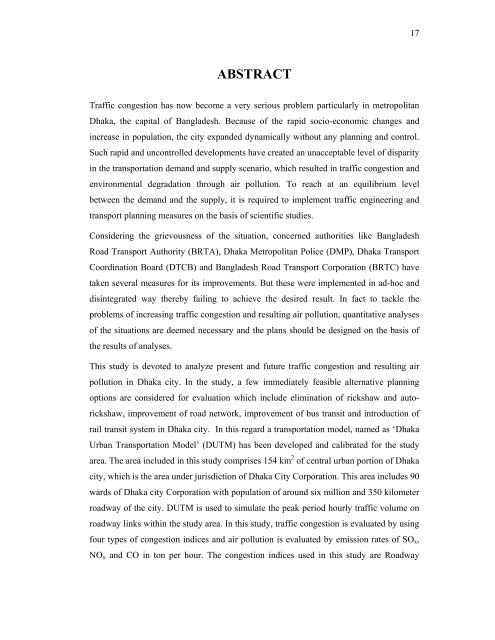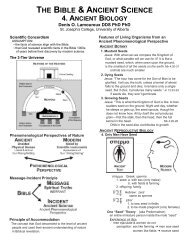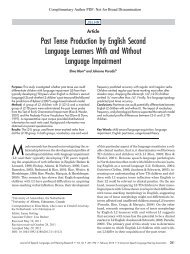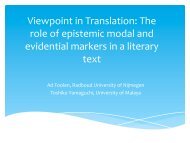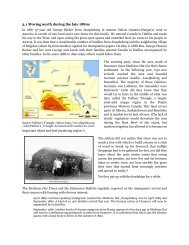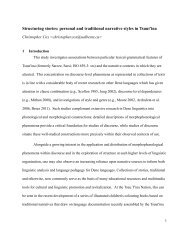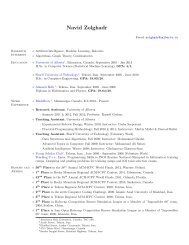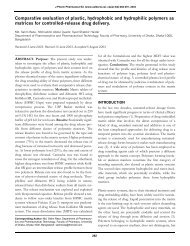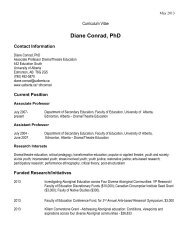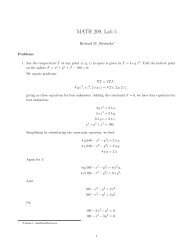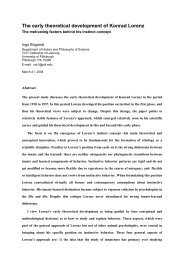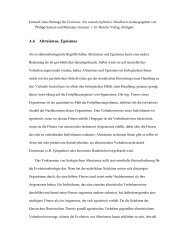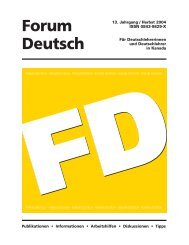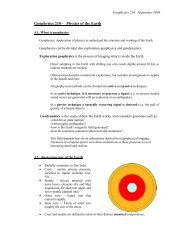Evaluation of Planning Options to Alleviate Traffic Congestion and ...
Evaluation of Planning Options to Alleviate Traffic Congestion and ...
Evaluation of Planning Options to Alleviate Traffic Congestion and ...
Create successful ePaper yourself
Turn your PDF publications into a flip-book with our unique Google optimized e-Paper software.
17<br />
ABSTRACT<br />
<strong>Traffic</strong> congestion has now become a very serious problem particularly in metropolitan<br />
Dhaka, the capital <strong>of</strong> Bangladesh. Because <strong>of</strong> the rapid socio-economic changes <strong>and</strong><br />
increase in population, the city exp<strong>and</strong>ed dynamically without any planning <strong>and</strong> control.<br />
Such rapid <strong>and</strong> uncontrolled developments have created an unacceptable level <strong>of</strong> disparity<br />
in the transportation dem<strong>and</strong> <strong>and</strong> supply scenario, which resulted in traffic congestion <strong>and</strong><br />
environmental degradation through air pollution. To reach at an equilibrium level<br />
between the dem<strong>and</strong> <strong>and</strong> the supply, it is required <strong>to</strong> implement traffic engineering <strong>and</strong><br />
transport planning measures on the basis <strong>of</strong> scientific studies.<br />
Considering the grievousness <strong>of</strong> the situation, concerned authorities like Bangladesh<br />
Road Transport Authority (BRTA), Dhaka Metropolitan Police (DMP), Dhaka Transport<br />
Coordination Board (DTCB) <strong>and</strong> Bangladesh Road Transport Corporation (BRTC) have<br />
taken several measures for its improvements. But these were implemented in ad-hoc <strong>and</strong><br />
disintegrated way thereby failing <strong>to</strong> achieve the desired result. In fact <strong>to</strong> tackle the<br />
problems <strong>of</strong> increasing traffic congestion <strong>and</strong> resulting air pollution, quantitative analyses<br />
<strong>of</strong> the situations are deemed necessary <strong>and</strong> the plans should be designed on the basis <strong>of</strong><br />
the results <strong>of</strong> analyses.<br />
This study is devoted <strong>to</strong> analyze present <strong>and</strong> future traffic congestion <strong>and</strong> resulting air<br />
pollution in Dhaka city. In the study, a few immediately feasible alternative planning<br />
options are considered for evaluation which include elimination <strong>of</strong> rickshaw <strong>and</strong> au<strong>to</strong>rickshaw,<br />
improvement <strong>of</strong> road network, improvement <strong>of</strong> bus transit <strong>and</strong> introduction <strong>of</strong><br />
rail transit system in Dhaka city. In this regard a transportation model, named as ‘Dhaka<br />
Urban Transportation Model’ (DUTM) has been developed <strong>and</strong> calibrated for the study<br />
area. The area included in this study comprises 154 km 2 <strong>of</strong> central urban portion <strong>of</strong> Dhaka<br />
city, which is the area under jurisdiction <strong>of</strong> Dhaka City Corporation. This area includes 90<br />
wards <strong>of</strong> Dhaka city Corporation with population <strong>of</strong> around six million <strong>and</strong> 350 kilometer<br />
roadway <strong>of</strong> the city. DUTM is used <strong>to</strong> simulate the peak period hourly traffic volume on<br />
roadway links within the study area. In this study, traffic congestion is evaluated by using<br />
four types <strong>of</strong> congestion indices <strong>and</strong> air pollution is evaluated by emission rates <strong>of</strong> SO x ,<br />
NO x <strong>and</strong> CO in <strong>to</strong>n per hour. The congestion indices used in this study are Roadway


